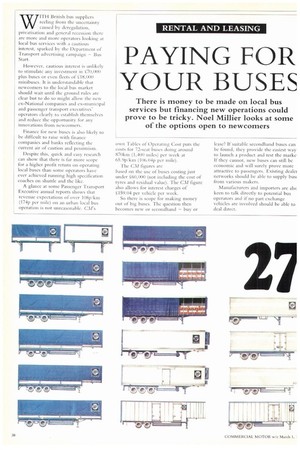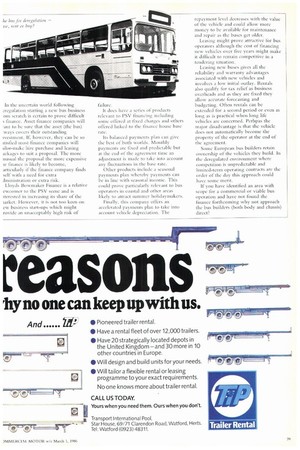PAYING FOR YOUR BUSES
Page 38

Page 39

If you've noticed an error in this article please click here to report it so we can fix it.
There is money to be made on local bus services but financing new operations could prove to be tricky. Noel Millier looks at some of the options open to newcomers
WITH British bus suppliers reeling from the uncertainty caused by deregulation, privatisation and general recession there arc more and more operators looking at local bus services with a cautious interest, sparked by the Department of Transport advertising campaign — Bus Start.
However, cautious interest is unlikely to stimulate any investment in 00,1100 plus buses or even fleets of U8,(01) minibuses. It is understandable that newcomers to the local bus market should wait until the ground rules are clear but to do so might allow the new ex-National companies and ex-municipal and passenger transport executives' operators clearly to establish themselves and reduce the opportunity for any innovations from newcomers.
Finance for new buses is also likely to he difficult to raise with finance companies and banks reflecting the current air of caution and pessimism.
Despite this, quick and easy research can show that there is far more scope for a higher profit return on operating local buses than some operators have ever achieved running high specification coaches on shuttle and the like.
A glance at some Passenger Transport Executive annual reports shows that revenue expectations of over 108p/km (174p per mile) on an urban local bus operation is not unreasonable. CM's own Tables of Operating Cost puts the costs for 72-seat buses doing around 870km (1,40(1 miles) per week at 65.9p/km (106.04p per mile).
The CM figures are based on the use of buses costing just under £.60.000 (not including the cost of tyres and residual value). The CM figure also allows for interest charges of i:159.04 per vehicle per week.
So there is scope for making money out of big buses. The question then becomes new or secondhand — buy or lease? If suitable secondhand buses can be found, they provide the easiest way to launch a product and test the marke If they cannot, new buses can still be economic and will surely prove more attractive to passengers. Existing dealei networks should be able to supply bus( from various makers.
Manufacturers and importers are alsc keen to talk directly to potential bus operators and if no part exchange vehicles are involved should be able to deal direct.
In the uncertain world following eregulation starting a new bus business oni scratch is certain to prove difficult finance. Asset finance companies will ,ant to be sure that the asset (the bus) ways covers their outstanding ivestment. if, however, they can be so itisfied most finance companies will dlor-make hire purchase and leasing ackages to suit a proposal. The more nusual the proposal the more expensive ie finance is likely to become, articularly if the finance company finds self with a need for extra
dministration or extra risk.
Lloyds Bowmaker Finance is a relative ewcomer to the PSV scene and is iterested in increasing its share of the larket. However, it is not too keen on ew business start-ups which might rovide an unacceptably high risk of failure.
It does have a series of products relevant to PSV financing including sonic offered at fixed charges and others offered linked to the finance house base rate.
Its balanced payments plan can give the best of both worlds. Monthly payments are fixed and predictable but at the end of the agreement time an adjustment is made to take into account any fluctuations in the base rate.
Other products include a seasonal payments plan whereby payments can be in line with seasonal income. This could prove particularly relevant to bus operators in coastal and other areas likely to attract summer holidaymakers.
Finally, this conipany offers an accelerated payments plan to take into account vehicle depreciation. The
repayment level decreases with the value Of the vehicle and could allow more money to be available for maintenance and repair as the buses get older.
Leasing might prove attractive for bus Operators although the cost of financing new vehicles over five years might make it difficult to remain competitive in a tendering situation.
Leasing new buses gives all the reliability and warranty advantages associated with new vehicles and involves a low initial outlay. Rentals also qualify for tax relief as business overheads and as they arc fixed they allow accurate forecasting and budgeting. Often rentals can be extended for a second period or even as long as is practical when long life vehicles are concerned. Perhpas the major disadvantage is that the vehicle does not automatically become the property of the operator at the end of the agreement.
Sonic: European bus builders retain ownership of the vehicles they build. In the deregulated environment where competition is unpredictable and limited-term operating contracts are the order of the day this approach could have some merit.
If you have identified an area with scope for a commercial or viable bus operation and have not found the finance forthcoming why not approach the bus builders (both body and chassis) direct?




























































